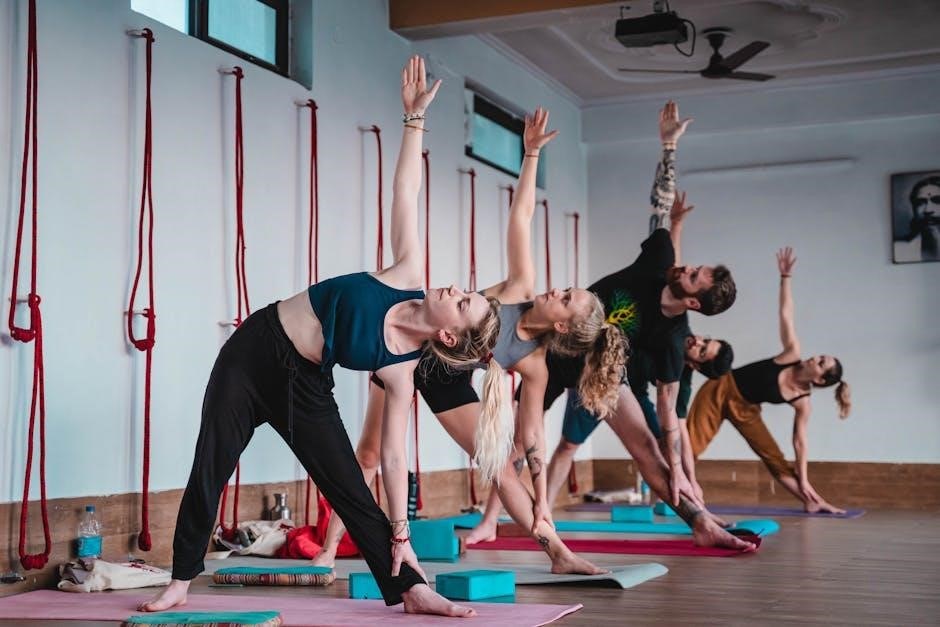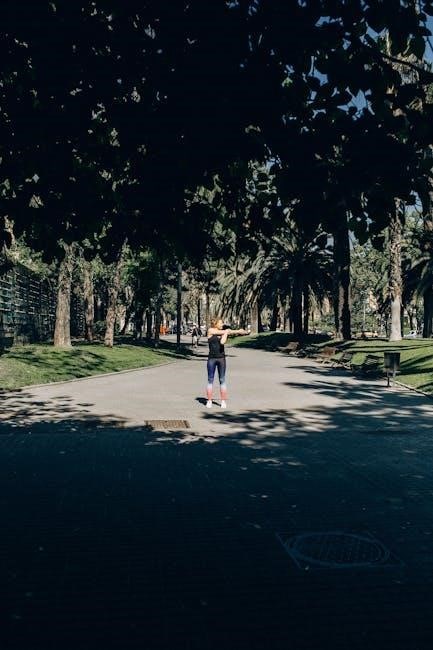Mindfulness is a powerful practice that helps students cultivate focus, calm, and emotional balance. Simple activities like breathing exercises and short meditations can be adapted to fit busy schedules, promoting mental well-being and academic performance. With just a few minutes a day, students can develop greater self-awareness and resilience, making it an essential tool for modern education.
Understanding the Importance of Mindfulness in Education
Mindfulness in education is essential for fostering mental well-being, improving focus, and reducing stress among students. It helps students develop emotional intelligence, enhancing their ability to manage emotions and build positive relationships. By incorporating mindfulness activities, educators can create a supportive learning environment that promotes resilience and self-awareness. These practices are particularly beneficial for students with ADHD or short attention spans, as they encourage calm and concentration. Regular mindfulness exercises not only improve academic performance but also equip students with lifelong skills to navigate challenges. This approach complements traditional teaching methods, ensuring a holistic development of students’ mental, emotional, and social health.
Simple Mindfulness Activities for Students with Short Attention Spans
For students with short attention spans, simple mindfulness activities can be highly effective. Short breathing exercises lasting 2-3 minutes, such as focusing on inhales and exhales, help calm the mind. Body scans, where students lie down or sit quietly to notice physical sensations, can also be done quickly. Mindful listening, where students identify different sounds in the room, engages their senses without requiring long focus. These brief practices are easy to incorporate into daily routines and can be adapted to fit any age group, ensuring mindfulness is accessible and enjoyable for all students, regardless of their attention capacity.

Popular Mindfulness Exercises for Daily Routines
Journaling, gardening, painting, yoga, and Tai Chi are popular mindfulness exercises. These activities combine physical movement with mindfulness, helping students stay focused and calm throughout the day.

Journaling, Gardening, and Painting as Mindfulness Practices
Journaling, gardening, and painting are excellent mindfulness practices for students. Journaling encourages reflection and emotional processing, while gardening fosters a connection with nature. Painting promotes creativity and presence. These activities help students focus, reduce stress, and develop self-awareness. By incorporating them into daily routines, students can cultivate calm and clarity, enhancing their overall well-being. These practices are simple, engaging, and adaptable to different age groups, making them ideal for schools. They also provide a healthy outlet for expression and growth, contributing to a more mindful and balanced lifestyle.
Yoga and Tai Chi for Combining Physical Movement with Mindfulness
Yoga and Tai Chi blend physical movement with mindfulness, offering students a holistic approach to well-being. These practices enhance flexibility, balance, and coordination while fostering a calm mind. Through deliberate breathwork and slow, intentional movements, students can improve focus and reduce stress. Yoga and Tai Chi are accessible to all fitness levels, making them ideal for classrooms. Regular practice can boost emotional regulation, self-awareness, and overall mental health. These activities not only strengthen the body but also nurture the mind, creating a sense of harmony and readiness for learning. They are powerful tools for integrating mindfulness into daily student routines.

Classroom-Friendly Mindfulness Techniques
Mindfulness techniques like deep breathing, short meditations, and mindful moments can easily be incorporated into daily routines. These practices improve focus, reduce stress, and promote calm, helping students stay engaged and resilient.
Guided Meditations and Breathing Routines for Focus
Guided meditations and breathing routines are effective tools for enhancing concentration and reducing stress among students. These practices involve short, focused exercises that help students center their minds and relax their bodies. For instance, a 5-minute breathing routine can be led by a teacher, guiding students to inhale deeply and exhale slowly, promoting calm and focus. Similarly, guided meditations can be tailored to specific age groups, incorporating visualization techniques or positive affirmations. These activities not only improve academic performance but also foster a sense of well-being, making them invaluable in classroom settings.
Creating a Mindful Classroom Environment
A mindful classroom environment fosters calm and focus, encouraging students to engage fully in their learning. Teachers can create this space by incorporating elements like soft lighting, calming colors, and organized seating arrangements that promote collaboration. Adding plants or nature-inspired decor can also enhance serenity. Designated quiet areas for reflection or deep breathing exercises further support mindfulness practices. Encouraging students to take mindful moments during transitions or lessons helps maintain a centered atmosphere. By intentionally designing the classroom environment, educators can cultivate a space where mindfulness naturally becomes part of the daily routine, benefiting both academic performance and emotional well-being.
Mindfulness Activities for Emotional Intelligence
Mindfulness activities enhance emotional intelligence by helping students recognize and manage emotions. Practices like empathy exercises and reflection foster self-awareness, improving social interactions and emotional regulation skills effectively.
Exercises to Enhance Focus and Social Development
Mindfulness exercises like guided meditations and breathing routines help students improve focus and social skills. Activities such as group mindful listening or sharing thoughts foster collaboration and empathy, enhancing interpersonal connections. Breathing exercises calm the mind, while mindful movement activities like yoga promote self-regulation and teamwork. These practices encourage students to engage thoughtfully with their surroundings, building both individual concentration and collective harmony in the classroom. Regular mindfulness exercises create a supportive environment where students can grow emotionally and socially, preparing them for challenges with confidence and cooperation.
Practical Strategies for Reducing Stress and Anxiety
Mindfulness offers effective strategies to reduce stress and anxiety in students. Techniques like grounding exercises, where students focus on their senses, help calm the mind. Visualization practices, such as imagining a peaceful place, can alleviate anxiety. Physical activities like stretching or mindful walking encourage relaxation and reduce tension. Group exercises, such as sharing gratitude or kind thoughts, foster a sense of connection and support. These practices help students manage stress and anxiety by teaching them to stay present and focused, creating a more balanced and resilient mindset. Regular mindfulness practice can lead to long-term emotional well-being and a positive classroom atmosphere.

Mindfulness Resources for Teachers
Teachers can access tools like the BOXED DECK of CARDS with 50 exercises and recommended books, providing creative ways to integrate mindfulness into daily student activities.
BOXED DECK of CARDS with 50 Mindfulness Exercises
The BOXED DECK of CARDS offers 50 creative mindfulness exercises tailored for children. Divided into categories like grounding, calm, and focus, these activities help kids connect to their inner wisdom. Each card features engaging games, visualizations, and practices designed to foster joy and resilience. Teachers and parents can use these exercises to help children improve focus, practice kindness, and relax. The deck is a practical tool for introducing mindfulness in classrooms or at home, making it easy to incorporate into daily routines. Its versatility ensures that students of all ages can benefit from these simple yet impactful mindfulness practices.
Recommended Books and Tools for Mindful Kids
For mindful kids, books like Mindful Kids: 50 Mindfulness Activities for Kindness, Focus, and Calm offer engaging exercises to foster emotional intelligence. Tools like the BOXED DECK of CARDS provide 50 creative mindfulness exercises, divided into categories to help children connect with their inner wisdom. These resources are designed to be fun and accessible, making mindfulness practices easy to incorporate into daily routines. Whether through guided meditations, visualizations, or interactive games, these tools empower children to develop focus, kindness, and relaxation skills. They are ideal for both classrooms and home use, supporting the emotional and mental well-being of students.
Mindfulness activities empower students with lifelong skills, enhancing focus, emotional resilience, and overall well-being, easily integrated into daily routines for future success and happiness.
The Long-Term Benefits of Mindfulness for Students
Mindfulness practices foster long-term improvements in focus, self-regulation, and emotional resilience. Students develop better stress management skills, leading to enhanced academic performance and mental well-being. Regular mindfulness activities cultivate compassion, empathy, and self-awareness, promoting positive social interactions. Over time, these practices help students build a stronger sense of calm and confidence, equipping them to navigate life’s challenges with greater ease and clarity. The consistent integration of mindfulness in education supports holistic development, empowering students to thrive both academically and personally.
